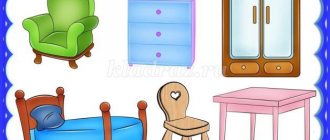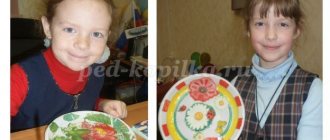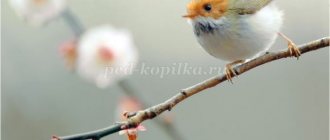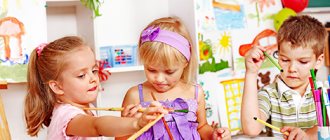Preview:
Developed and conducted by L.V. Yanpolskaya, senior teacher
Purpose: 1. Give children the concept of sleep. Show the meaning of sleep in a person’s life;
Objectives: 1. Explain to children the physiology of sleep; 2. Familiarize yourself with the basic hygienic rules of sleep. 3. Develop hygiene skills and abilities of children. 4. Cultivate a sense of responsibility in yourself so as not to disrupt your daily routine. 5. Activation of the dictionary: Dream bag, clothespins, jug.
Preliminary work: 1. Introduction to bedding. 2. Visit to the laundry room in kindergarten. 3. Exhibition of children's drawings “Magic Dreams”. 4. Children's games with dolls. 5. Selection of folk lullabies: “Tired toys are sleeping” (lyrics by Z. Petrova, music by A. Ostrovsky)
Equipment: 1. Sleep hygiene support charts, 2. illustrated pictures with toiletries, 3. children's beds, 4. dolls, 5. pastels, 6. audio cassettes, 7. art books.
Methodical techniques: 1. Surprise moment; 2. Exhibition of hygiene products; 3. Poems; (S. Marshak “Here under your back”, “Lullaby”, V. Nesterenok “Tricky pillow”, F. Pestryakov “Blizzards are rustling outside the window” 4. Problem situation “Sleep hygiene” 5. Physical exercise; 6. Games; 7. Guessing riddles 8. Summary.
Program content: 1. Give the concept of first aid for sunstroke, heatstroke, fainting, insect bites, bleeding, fractures, poisoning; 2. Introduce artificial respiration techniques, its meaning and necessity. 3. Continue to introduce the circulatory system 4. Nurture the moral and volitional qualities of the individual, mercy, compassion, mutual assistance, mutual assistance. 5. Activation of vocabulary: Artificial respiration, dislocation, proteins, etc.
Preliminary work: 1. Invite the head nurse to the group and talk about first aid, 2. Play the role-playing game “Ambulance”
Equipment: 1. telephone, 2. medical bag, 3. table “Providing first aid; for fractures and dislocations”, 4. scarf, 5. doll, 6. pencil.
Methodical techniques: 1. Surprise moment “Ambulance”. 2. Problem situation “Providing first aid”. 3. Teacher’s story “Medicinal herbs.” 4. Practical “Artificial respiration” 5. Visual “Display of the first aid kit” 6. Physical exercise “Pinocchio”. 7. Games. 8. Summary.
Source
"Me and my health." Valeological games and exercises
According to the World Health Organization, “health is a state of complete physical, mental and social well-being and not merely the absence of disease or injury.”
A number of factors influence a child’s health:
- heredity (share of influence is 20%)
- environmental impact (share of influence - 20%)
- medical care (share of influence - 10%)
- lifestyle (share of influence - 50%).
These data force us to pay the most serious attention to the fourth group of factors. It consists of the child’s attitude to his health, his nutrition, adherence to the daily routine, physical activity, hardening, proper sleep, and mastery of hygiene skills. The games and exercises offered in this section will help children develop the right attitude towards their health.
Who do I look like? Goal: developing the ability to look at oneself from the outside, compare a person with other animal organisms, find similarities and differences, promote the development of imagination.
Material: photographs of parents, other close relatives of children, prizes.
Description: invite children to carefully look at the photographs and find similar features. The one who finds the most signs wins a prize.
Who was born
Goal: to consolidate children’s ideas about how living beings are born.
Equipment: three large pictures depicting an egg, caviar, a bottle of milk and a pacifier; small pictures depicting people, animals, birds, amphibians, insects.
In front of the children are pictures with animals, insects, amphibians, and people turned upside down. Children choose any picture and tell how this creature was born. Then they combine a small picture with a large one - with the image of an egg, an egg, a bottle with a nipple (for mammals).
Gardener
Goal: familiarization with the external structure of the human body, to develop the ability to see the good in other people.
Description: children stand in a circle, the leader is the gardener in the center. He utters the following words: “I was born a gardener, I was seriously angry, I was tired of all the flowers, except for Yulenka! “Then the “gardener” talks about Yulenka’s virtues. Then Yulenka becomes the leading gardener. She chooses one of the guys and tells why he (s) is good, thus explaining her choice.
Name it correctly
Goal: to consolidate knowledge about hygiene products, their purpose and correct use.
Material: subject pictures of various subjects, including images of hygiene products, chips.
Description: children choose from a variety of items those that help them take care of themselves. For example: “I wash my face” (what objects help you with this), “I take a shower,” etc. For the right choice - a trick.
Choose clothes according to the seasons
Goal: developing the ability to distinguish items of clothing depending on the time of year.
Material: items of clothing used in different seasons, 4 dolls.
Description: children are divided into teams, each of which “dresses” its doll for a certain time of year.
Who needs what to live?
Goal: consolidation of knowledge and ideas about the basic needs of living organisms for warmth, air, food, habitat.
Material: cards depicting living beings (human, dog, tree, flower, etc.; cards depicting food, habitat.
Description: invite children to choose a pair for each card, answering the questions - choose what the bird needs to live? What does a dog need so that it can live.
Who am I?
Goal: expanding the child’s knowledge about himself, his name, his surname, age.
Equipment: mirror; subject pictures depicting animals and birds.
Tell us what you know about yourself (name, age, height, hair color and length, eye color, date of birth, girl or boy).
Tell me who you are like: mom or dad.
Do you have signs that are present in any animal or bird?
Health traffic light
Goal: developing ideas about a healthy lifestyle.
Material: circles of red, yellow, green colors, subject pictures.
Description: offer to “light” the health traffic light. The green circle is what helps a person lead a healthy lifestyle; yellow is something that needs to be treated with caution, red circle is something that is harmful to health.
Name the athlete
Goal: to develop a respectful attitude towards athletes, to develop the ability to distinguish and name sports.
Material: pictures of athletes.
Goal: to develop a respectful attitude towards athletes, to develop the ability to distinguish and name sports.
Description: Children play in pairs. One takes a picture of an athlete and shows the given sport with a movement, the other guesses. Then the players change places.
Where are the vitamins hidden?
Goal: to consolidate the understanding of vitamin groups, their importance and health benefits.
Material: baskets with letters indicating groups of vitamins (A, B, C); dummies of fruits and vegetables.
Description: suggest placing the dummies in baskets with the corresponding group of vitamins.
What first - what then (daily routine)
Goal: to reinforce the idea that following a proper daily routine is good for health.
Material: plot pictures depicting actions characteristic of a certain period of the day.
Description: invite players to arrange the pictures in the correct sequence and explain their choice.
Sun, air and water are our faithful friends
Goal: to form an idea about the means and types of hardening (water, air, solar), their importance for health.
Material: story pictures.
Description: children look at the pictures and determine what health benefits the sun, air and water bring. The one who names the most useful properties wins.
Why did the guys get sick?
Goal: to develop the ability to identify cause-and-effect relationships, cultivate a caring attitude towards one’s health, and develop coherent speech.
Material: plot pictures depicting correct and incorrect actions (leading to illness).
Description: children choose pictures depicting incorrect actions and explain their choice.
Name it correctly (medicines)
Goal: familiarize yourself with the names of medications that are used for treatment and which are part of the “home medicine cabinet.”
Material: pictures depicting medications included in the “home first aid kit”, “first aid kit”.
Description: children are invited to assemble a “home first aid kit”, naming medications, and explain their choice.
Choose medicinal plants
Goal: familiarize yourself with the names of medications that are used for treatment and which are part of the “home medicine cabinet.”
Material: subject pictures depicting plants, “Aibolit” doll.
Description: children choose medicinal plants from all the proposed pictures, and “Aibolit” explains what medicinal properties they have.
How should you take care of yourself?
Goal: developing skills to monitor compliance with personal hygiene rules.
Equipment: top, chips, cards with questions.
The presenter spins the top, which determines the card with the question. For the correct answer, the child receives a chip. The one with the most chips wins.
Questions
1. Name the items you need for washing (soap, towel).
2. Name the items you will need to take a shower (shampoo, soap, shower gel).
3. How often should you wash? (Every day).
4. How often should you brush your teeth? (In the morning and in the evening).
5. How often should you cut your nails? (At least once every 10 days).
6. How often should you wash your ears? (Every day).
7. How often should you change your underwear? (Every day).
Show me and I'll guess
Goal: to develop a respectful attitude towards athletes, to develop the ability to distinguish and name sports.
Description: one subgroup of children, using specific movements, shows (makes a guess) what kind of sport they are involved in. Another subgroup guesses who was depicted (skier, swimmer, hockey player, gymnast, etc.).
Good words
Goal: to create a desire to see the good in other people, the development of speech and imagination.
Description: children stand in circles, pass the ball around the circle, name one of the good qualities of their neighbor or call him by an affectionate name.
Making a menu
Goal: developing the idea that health depends on proper nutrition - food should not only be tasty, but also healthy.
Material: play dishes, dummies of fruits, vegetables, food.
Description: The presenter tells the players: “In front of you is a table set for lunch (dinner). Put in the first plate what you want to eat first, then fill the second plate, and the dessert bowl. Mark those players who filled their plates with more than just sweets, and who “created a menu” that is healthy.
To keep your skin healthy
Goal: developing skills to monitor compliance with personal hygiene rules.
Equipment: pictures marked with a red rim with incorrect actions of children.
Children look at the pictures and find what is wrong. For the correct answer, the child receives a chip. The one with the most chips wins.
Images
The child licks abrasions and cuts.
Boy in dirty underwear.
The girl puts on someone else's shoes.
What do we know about things?
Goal: to expand children’s understanding of the rules of safe behavior at home; develop attention and memory; foster a sense of cooperation.
Material: four playing cards depicting a cut, burn, hand bruise and fire; pictures depicting various household items.
Description: 4 children take part in the game, each of them takes a game card with the image of an “injury”. The teacher (child) is the leader. He picks up a picture of an object one by one. Participants must guess what injury could result from improper handling of this item, match it to their card and take the picture. When selecting, the child must explain why this or that object is dangerous and tell the rules for handling it.
Author: Olga Vladimirovna Mozdukova, teacher at MBDOU “Kindergarten No. 3”, Belovo, Kemerovo region, Russia.
The article is published in the author's edition.
Summary of an open lesson on valeology for the senior group “Journey to the Land of Health”
Educator: Well, guys, let's hit the road. Look, the poster shows a human body, let's make sure you know all the parts of the body. (The teacher names: arms, legs, neck, knees, elbows, etc.)Educator: Who are these terrible creatures around the human body? Educator: Are microbes dangerous for humans? Educator: Indeed, the microbe is a terribly harmful animal: insidious and, most importantly, ticklish. Such an animal will crawl into your stomach and live there quietly. He will climb, the scoundrel, wherever he wants. He will walk on the patient and tickle him. He is proud that he causes so much trouble: And a runny nose, and sneezing, and sweat. We absolutely must save this boy. Guys, what are microbes afraid of? Educator: How do microbes get into our body? Educator: You answered correctly. If you do not wash your hands before eating or put unwashed food into your mouth with dirty hands, then germs can enter the human body along with the dirt. We can also inhale air contaminated with microbes, but there is an obstacle in the way of the microbes - our nose. The human nose is designed in such a way that the air passing through it is warmed and purified. Therefore, it is best to breathe through your nose. And also, in order for our nose to strengthen, we must do special exercises. Let's do this exercise. - stroke your nose from tip to bridge, inhale, and as you exhale, tap the wings of your nose with your index fingers; - take 8-10 inhalations and exhalations through the right nostril, then through the left, in turn, closing the resting one with the index finger; — inhale through your nose, and as you exhale, draw out the sound mmmm, while simultaneously tapping your fingers on the wings of your nose; - while exhaling, open your mouth wide and stick out your tongue as far as possible, trying to reach the chin with the tip, while silently saying a-a-a
Well, now you understand why babies need a nose! I really need every nose, since it has grown to my face. In the hot summer, on the meadow, the nose smells the flowers. In the clearing, strawberries. In the garden bed, ripe strawberries. In the garden, the nose smells where the garlic and onions have grown. Educator: And now the next riddle from Vitaminka: She gave us sounds that we must guess. (Various sounds are included)
Educator: Well done, you guessed all the sounds, but with what help do we hear and distinguish sounds? Educator: You also need to protect and care for your ears. What can harm our ears? Educator: Now let's play with the ears so that they are strong too. (massage of biologically active points) Come to me, my friend, And quickly sit down in the circle Find your ears And show me quickly. That's how we clap our ears, Now we'll pull everything down. Ear, don't fall off. And then, and then They twisted the tragus. The ear seemed to be frozen, so you can warm it up. So the game ended. There was silence.
Educator: tell me, what do we need eyes for?
Do you need to take care of your eyes?
Who do we go to for eye exams?
Exercise for the eyes.
Working with pictures (indicate with an arrow what the eye sees, what the nose feels, what the ear hears). Educator: look, again some drawings - Vitaminka prepared riddles for us. What could they mean?
Presentation of healthy lifestyle
Educator: again everyone guessed: To be strong and agile, you need to be friends with the sun. In the morning, get up before everyone else and do exercises. Everyone knows, everyone understands that it’s nice to be healthy. The sun, air, sports, water are our best friends.
Educator: And now another riddle of Vitaminka. What do you think this is? (a model of a diseased tooth is placed on the easel) Educator: Yes, this is a spoiled diseased tooth, in which microbes also live. Why did the tooth deteriorate? Educator: Let's check if you know which foods are healthy and which are harmful to your teeth?
Educator: Do you know how to brush your teeth properly? How many times a day?
Showing pictures of healthy and diseased teeth.
Educator: You should also not chew hard objects and you need to visit the dentist on time. Then terrible toothache and harmful microbes will never be able to settle in your beautiful healthy teeth. Here we seem to have arrived. (Vitaminka appears from behind the screen) Vitaminka: Hello, guys, you are so great. All my riddles were solved. Do like the bunnies, girls and boys. In the morning, get up at the crib, quickly do exercises. After washing thoroughly, sit down at the table as soon as possible. And after breakfast, the bunnies - these friendly guys - always brush their teeth with a brush and toothpaste for 3 minutes, then run to the kindergarten, but don’t bite the sweet sugar. Hares take care of their teeth. Hares love to eat apples and pears, and delicious carrots and crunchy cabbage, and, of course, milk, cow's milk. After all, everyone knows that it contains strength and health. After the garden, the whole crowd returns home. At home, a delicious dinner awaits them - cabbage soup with fresh cabbage. The hares quickly eat everything and want to wash themselves, rinse their mouths with water, and go for a walk with their mother. You guys try to do the same as the bunnies and then the toothache will leave you forever.
Educator: Vitamin, our children also know a few tips that must be followed in order to be healthy.
Senior group. Senior preschool age. Children 5-6 years old
Summary of GCD for a valeology lesson in the senior group “Skillful Fingers” Valueology lesson on the topic : “Skillful Fingers”
Program content: 1. To form children’s initial knowledge about an important sensory organ - the hand, to continue to introduce them to the functions of the hand and fingers. 2.Develop fine motor skills of the hands, coordination of movements and fingers, deepen and develop.
Publication “Lesson summary on valeology for senior preschool children. » Program content: 1. Give children the concept of sleep; 2. Show the meaning of sleep in a person’s life; 3. Explain to children the physiology of sleep; 4. Familiarize yourself with the basic hygienic rules of sleep. 5. Develop hygiene skills and abilities of children. 6. Cultivate feelings in yourself.
Quest on valeology for children 5–6 years old “Ears, nose and eyes always help us” Web quest on the topic “Ears, nose and eyes always help us. Goal: to form an idea of the role of the senses in the perception of the surrounding world. Objectives: • To introduce children to the senses and their significance for humans. Teach children to make simple conclusions. • Develop.
Synopsis of an educational lesson in the senior group on valeology “Flower of Health” Municipal autonomous preschool educational institution No. 16 “Ryabinka” in the city of Dubna, Moscow region SYNOPSIS OF COGNITIVE LESSON in the senior group on valeology TOPIC: “FLOWER OF HEALTH” (preparing vinaigrette) Teacher of the Highest Qualification Category Shpagina.
Summary of a lesson on valeology in the senior group “The nose, ears and eyes always help us” Topic: “The nose, ears and eyes always help us” Purpose: To give children an idea of the senses as our assistants in understanding the world around us. Objectives: Educational: clarify and consolidate children’s knowledge about the organs of hearing, vision, and smell; expand and deepen knowledge about.
The article “Summary of GCD on valeological education of children 5–6 years old” “In search. » Topic: “In search of the magic flower of Health” Purpose: to consolidate children’s understanding of methods of maintaining health. Objectives: Educational: to reinforce the idea of a healthy lifestyle and the need to take care of your body. Developmental: develop a sustainable interest in.
Abstract of educational activities in valeology using ICT with children of senior preschool age “What we are inside” Summary of direct educational activities in valeology using ICT in senior preschool age. Topic: “What we are like inside.” Prepared and conducted by: E.V. Fedorova, teacher of the preschool educational institution "Ogonyok". G.Nadym 2021 Age group: senior preschool age. Target.
Abstract of the GCD on valeology “Purification of the soul” for older preschool age in the technique of fairy tale therapy “Purification of the soul” Goal: To form in children a conscious desire to be healthy. Objectives: To teach acceptable ways of expressing the removal of negative feelings and emotions. Removing negative moods, restoring strength, developing the ability to cooperate, understand the feelings of others, and provide.





